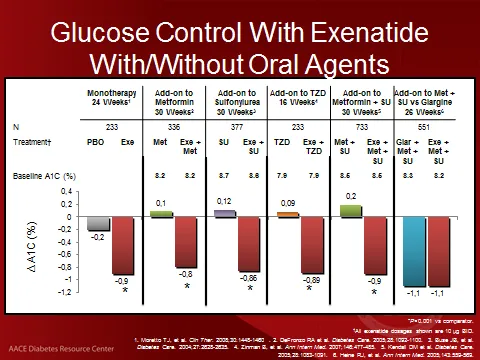This has been shown by the results of the phase III 'Duration-8' essay, the first clinical study in which these two antidiabetic treatments, an agonist from the GLP-1 receptors and a SGLT-2 inhibitor, added to theStandard treatment to evaluate potential benefits in patients with type 2 diabetes that have inappropriate glycemic control.
"The progressive nature of type 2 diabetes causes patients to require multiple antidiabetic treatments to achieve and maintain glycemic control. The results of 'Duration-8' show that the combination of medications with different mechanisms of action can significantly reduce levelsof HBA1C, and as an additional benefit the weight and systolic blood pressure, "said the director of the Endocrinology Division and the Sidney Kimmel Medical College Diabetes Center of the Thomas Jefferson University (Philadelphia), Serge A. Jabbour.
These results have been presented in the 52nd edition of the Annual Congress of the European Association for the Study of Diabetes (EASD) and held in Munich (Germany) and have been published simultaneously in 'The Lancet Diabetes & AMP;Endocrinology '.
Effectiveness in patients who do not work metformin
Specifically, the work reached its main assessment criteria with the combination of exenatida and dapagliflozina by significantly reducing the HBA1C levels with respect to the basal level, compared to the individual use of exnatida or dapagliflozine at 28 weeks.He also confirmed the great efficacy of Dapagliflozine in patients who fail to achieve their target of metformin.
"With 'Duration-8', Astrazeneca becomes the first biopharmaceutical company that highlights the potential benefits of combining an agonist of the GLP-1 receptors and a SGLT-2 inhibitor as a highly effective alternative treatment to the therapies notInsulinics that are used in patients with severe and not controlled type 2 diabetes.He has asserted the vice president and director of cardiovascular and metabolic diseases of the Astrazeneca medication development department, Elisabeth Björk.
The secondary assessment criteria of the test included variations in body weight and systolic blood pressure.Compared to patients who only received exenatida or dapagliflozine, patients who received the combination of both drugs experienced significantly greater reduction in body weight, weight reduction observed with the combination of both drugs was higher (-4.5 kg) in patients in patientswith a basal HBA1C level of 8.0-9.0*percent, and there was a significantly higher decrease in systolic blood pressure.
Finally, the combination showed rates of adverse events and serious adverse events similar to treatment groups with each individual medicine.The most common adverse events were diarrhea, nodules at the injection point, nausea and urinary tract infections.


